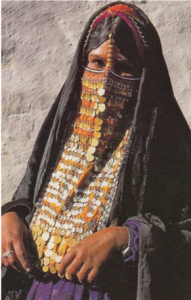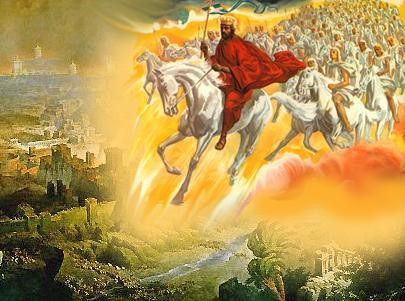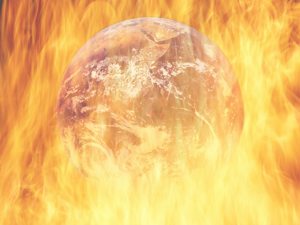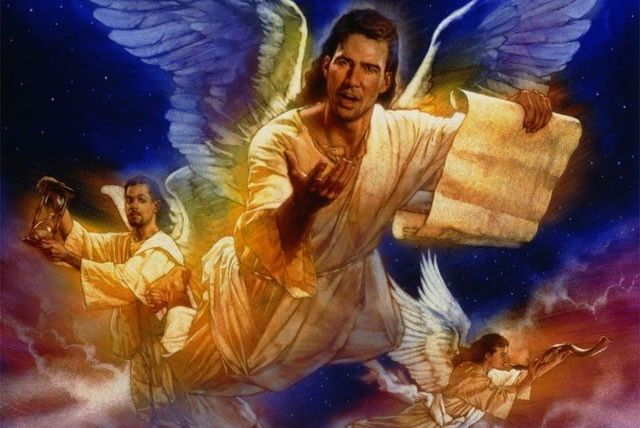Book of Revelation – a series presented by pastor Michael Walker
Lesson #21 – Revelation, chapter 19
Once again, we are directed to the Last Judgement. Whereas we were previously shown the contrast between the Two Harvests, we now view the contrast between The Marriage Supper of the Lamb and The Great Supper of God. Questions, however, need answering such as when does the wedding between Christ and His bride take place, when does the Marriage Supper take place, when does the betrothal happen and how much was the wedding dowry? Clarification concerning the gruesome portrayal of the destruction of the wicked also needs answers. These questions are all found in the Bible.
Chapter 19

If it is the case that chapters 18-20 follow in chronological order, then the anthem of praise featured in Revelation 19:1-8 would take place after the Second Advent; however, others may view this section taking place at the time of His return or just before. While it cannot be determined with certainty which is the correct view, this lesson, takes the position that it occurs immediately after Christ’s return for reasons outlined below.
Tremendous Praise in the Throne-room of the Universe (vs 1-8)
v. 4
These verses summarize the height of her wickedness: – She sits on the scarlet beast that is full of blasphemies. She is clothed in purple and scarlet. She is adorned with gold and precious stones. She holds a golden cup full of abominations and the filthiness of her fornication. She is drunk with the blood of the saints and martyrs. Her name is “Mystery, Babylon the Great, the Mother of Harlots and of the Abominations of the Earth”.
vs. 1, 6
In addition, it also mentions “a great multitude”, previously referred to in Revelation 7:9-12, who are “standing before the throne and before the Lamb, robed in white, with palm branches in their hands” [c.f. Lesson 6: The Sealing of God’s Faithful People]. It is therefore logical to believe that this occasion is taking place after the Second Coming of Christ when the redeemed have been rescued from this corrupt and wicked world that had become so controlled by Babylon’s rule [c.f. Lesson 20: God’s Judgement on the Harlot, the Beast and the Devil].
v. 2
They praise God for His “true and righteous” judgements and that “He has judged the great whore” and “has avenged on her the blood of His servants”. The Greek is specific that this is a single, completed act. That act was witnessed when the Babylonian harlot met her doom under the 7th Plague (Revelation 16:19) when God gave His judgement against her (Revelation 18:20-24).
v. 7
They also praise God because “the marriage of the Lamb has come and the bride has made herself ready”. The marriage took place before the Second Advent at the Close of Probation when Christ claimed His bride.
v. 9
The Marriage Supper of the Lamb will take place in Heaven. We shall examine this in more detail in the next section below.
The Marriage Supper of the Lamb

Before we examine the Marriage and the Marriage Supper, we need to be clear about whom the bride (wife) represents. In vision, John saw the “New Jerusalem coming down out of heaven from God prepared as a bride adorned for her husband” – Revelation 21:2 (c.f. Revelation 21:9,10). Elsewhere Christ refers to His Church as His betrothed or even His wife: Hosea 2:19,20; Isaiah 61:10; 62:5; 2 Corinthians 11:2; Ephesians5:22-33. The Holy City will be occupied by God’s faithful people; so both the Church and the Holy City are metaphors for Christ’s Bride: they are a corporate entity that belongs to Christ, the Bridegroom Who becomes her Husband (Isaiah 54:5).
Our Western concept of a wedding is quite different from that spoken of in the Bible. In order to understand what the Bible refers to either in an historical, parabolical or even a theological sense, we need to view a wedding through Eastern eyes back in Biblical times. It consisted of 5 stages – namely: betrothal, wedding dowry, period of separation and preparation, marriage, and wedding supper: –
1. The Betrothal was taken more seriously than it is today because it was seen as a more binding engagement, usually for life. This is evident from what the Lord says to His people when He declares, “I will betroth you to me forever” – Hosea 2:19. It would have been for this reason that during their period of betrothal Mary was found to be pregnant, that Joseph is referred to as “her husband” who sought to put her away (divorce) privately even though their marriage had not yet taken place and been consummated (Matthew 1:18-20).

2. The Wedding Dowry was part of the contract as the bride-price. This was paid to the virgin’s father as a gift, either in monetary terms or something else of a substantial nature. It was recorded in the marriage contract and was basically intended as a security for the bride if for any reason she was bereft either by death or departure. The woman in the parable that Jesus told, who lost one of her 10 silver coins, was no doubt concerned about her dowry (Luke 15:8-10). This photograph shows a Bedouin girl wearing a niqab containing her dowry composed of silver coins and jewellery.
3. The Period of Separation and Preparation was used for the bride to make her personal preparation while the bridegroom prepared their home that they would share together.
4. The Marriage comprised a simple ceremony and the family and guests joined the procession as the bridegroom and the bride made their way to the wedding feast and the bridegroom gave public recognition that he claimed his bride by throwing his cloak around her shoulders (c.f. Matthew 25:1-10).
5. The Marriage Supper was usually at the home of the bridegroom’s father who provided the feast in honour of his son. It was a great time of celebration and rejoicing; and it lasted at least for several days. If it was a royal wedding, the king would bequeath a city or province to the couple as a gift of affection.
We shall now apply these 5 stages to this prophetic chapter: –

The Betrothal: Accepting Christ’s invitation to unite our life with Him by committing ourselves to Him as our Lord and Saviour (John 6:37; 15:9; Romans 10:9; 2 Timothy1:12; 1 John 5:10-13).
The Wedding Dowry was paid by the Father in infinite love for the world by giving His dear Son, Jesus, as an atoning sacrifice for our sins (John 3:16; Isaiah 43:1; 1 Corinthians 6:20; Ephesians 1:11-14; 1 Peter 1:18,19).
The Period of Separation and Preparation was when Jesus ascended to Heaven with the assurance that He would return (John 14:18,19,27,28; Acts 1:9-11).
Jesus has gone to prepare a place for us (John 14:1-3), while in the meantime, His bride, the Church, is to prepare herself for His return because when Christ returns she will have “made herself ready”- Revelation 10:7 (c.f. Matthew 24:44; Luke 21:36; Romans13:11-14; Galatians 3:27; 1 Thessalonians 5:1-11; Titus 2:11-14; Hebrews 12:1,2).
The Marriage of the Lamb takes place at the Close of Human Probation when Jesus completes His intercession in the Most Holy Place of the Heavenly Sanctuary. It is at that time that He receives His Kingdom that is composed of all the saved (Daniel 7:13,14).
“I saw that while Jesus was in the most holy place He would be married to the New Jerusalem; and after His should be accomplished in the holiest, He would descend to the earth in kingly power, and take to Himself the precious ones who had patiently waited His return”
– E.G. White, Early Writings, p.251. [Recommended further reading: Early Writings, 55, 280].

v. 7
As previously noted, The New Jerusalem is also the bride synonymous with Christ’s faithful people who will occupy that Holy City. When Jesus entered the Most Holy Place in 1844 [c.f. Lesson10: The Arrival of God’s Last-day Prophetic Movement; and Lesson 12: Judgement on the Kingdoms of the World], the Investigative Judgement commenced to determine who would share Christ’s Kingdom (c.f. Daniel 7:26,27). From that time forward, we enter by faith into that throne-room (Hebrews 4:14-16; 6:19,20; 10:19-23) [c.f. E.G. White, The Great Controversy, 426,427].
v. 8
Having made public recognition before the onlooking universe of His chosen bride by clothing her with His pure robe of righteousness (Isaiah 61:10), Jesus now returns in what will be the most glorious procession and take His bride to the home He has prepared for her.
v. 8
The Marriage Supper will take place in Heaven, The Father’s House, where we shall sit down with all the true and faithful saints throughout the ages (Matthew 8:11; Luke 22:29,30). As this is a Royal Wedding, the Father has bestowed the Holy City for Christ and His bride to dwell in as His gift of affection for His Son and His bride. What a time of celebration and jubilation that will be!
The Faithful and True Rider on the White Horse (v 11-16)
This chapter focuses on two contrasting events: the rescue of the redeemed from this corrupt world and the final eradication of the wicked. Although there will be 1,000 years between these events (Revelation 20:1-6), the Second Coming of Christ will mark this separation period.

White horses were often the favourite of kings or generals and particularly as they led their armies into battle. In this vision, John saw Jesus, the “King of kings and Lord of lords” riding majestically and victoriously from Heaven into battle and leading His army. They too are mounted upon white horses and clothed in pure white linen, the symbol of purity and righteousness. The King Himself comes in righteousness to carry out judgement upon His enemies and to deliver His faithful people. The enemy was defeated at Calvary (Revelation 12:10-12). This is also highlighted by His robe that has been dipped in blood. Upon His head are many crowns (Greek: diadêmata) crowns of royalty. His eyes are like a flame of fire (Revelation 1:14) indicating the intensity of His gaze and discernment (Hebrews 4:13).
“His name is called The Word of God” – He is our Creator Who came and dwelt amongst us and revealed His character (John 1:1-5, 14). “From His mouth comes a sharp sword” – His Word is likened to a two-edged sword that can pierce through to the inner being (Hebrews 4:12); and with that same voice He will destroy the wicked (2 Thessalonians 2:8). “He will rule them with a rod of iron”. Jesus is the Good Shepherd (John 10:11) Who uses His rod. This had a crook on the end to assist in guiding and rescuing his flock; but on the other end was an iron ferrule that was used as a weapon to protect the flock. “He will tread the winepress of the fury of the wrath of God Almighty”. Christ experienced this wrath when He experienced separation from the Father when He took our place and died for our sins (Matthew 27:46;). This is why His robe is covered in blood (c.f. Isaiah 63:1-6) Only those who reject Him will be left to suffer that wrath at the time of the Great Vintage Harvest in the Final Judgement (Revelation 14:17-20) [c.f. Lesson18: The Two Harvests].
The Great Supper of God (v 17-21)
God is warning humanity today about the consequences of rejecting His mercy. We have the choice of either celebrating the Marriage Supper of the Lamb or this gruesome alternative of being destroyed at the Great Supper of God.
vs 17,18, 21
This metaphorical description of the destruction of the wicked, is a gruesome way of portraying their final end, by being torn to pieces by scavenging birds and animals. It draws on the curses that were uttered against the rebellious during the time when ancient Israel would suffer the consequences of their contemptuous behaviour toward God and His gracious warnings (Jeremiah.7:30-34; Ezekiel 39:17-21). Moses used similar metaphors in addressing the Israelites (Deuteronomy 28:25,26).
Finally, the language changes from metaphorical to literal terminology in describing the final destruction of the wicked:
v. 19
1,000 years after the Second Coming of Jesus, the wicked will be raised to face the final phase of judgement. Satan will once again deceive them into thinking they can overpower Christ and they prepare for the attack (Revelation 20:7-10).

vs 20-21
Then they will be cast into the lake of fire which will devour them completely until they are turned into ashes (c.f. Malachi 4:-3).
The full video presentation is available below:




